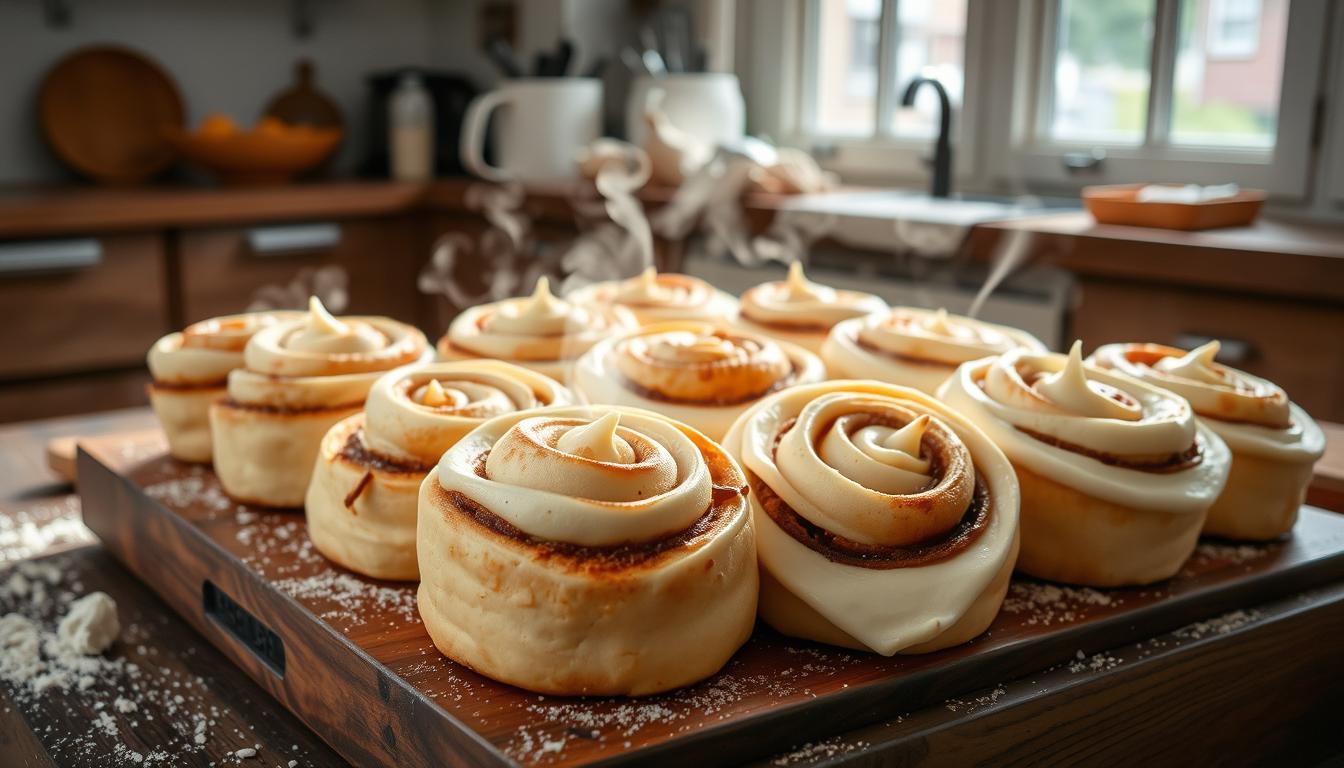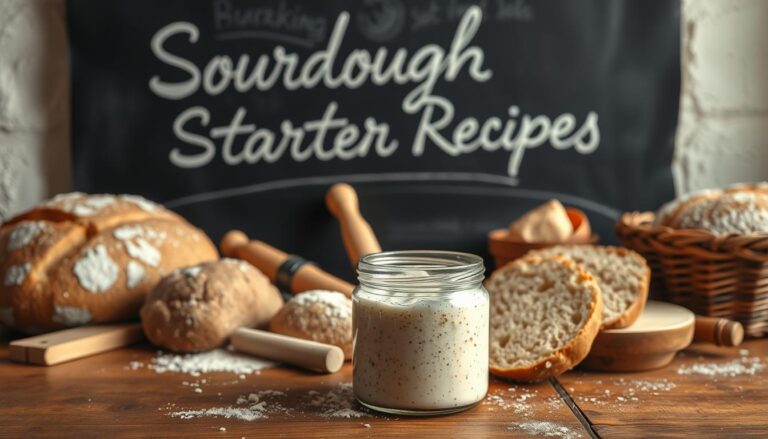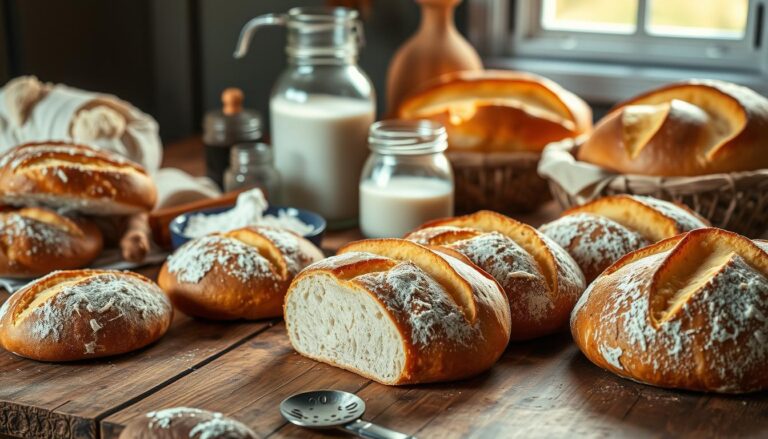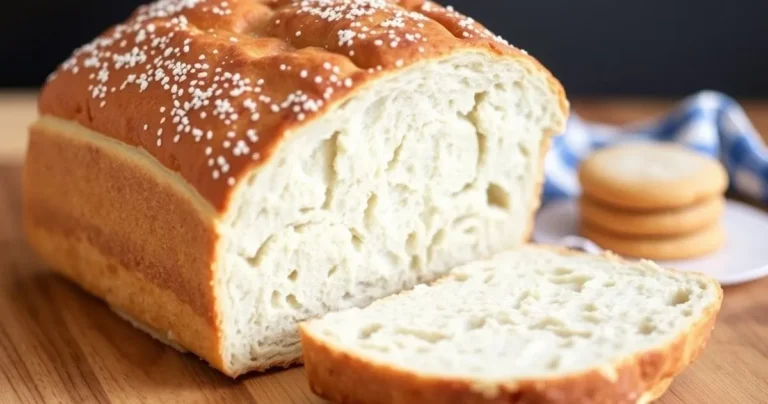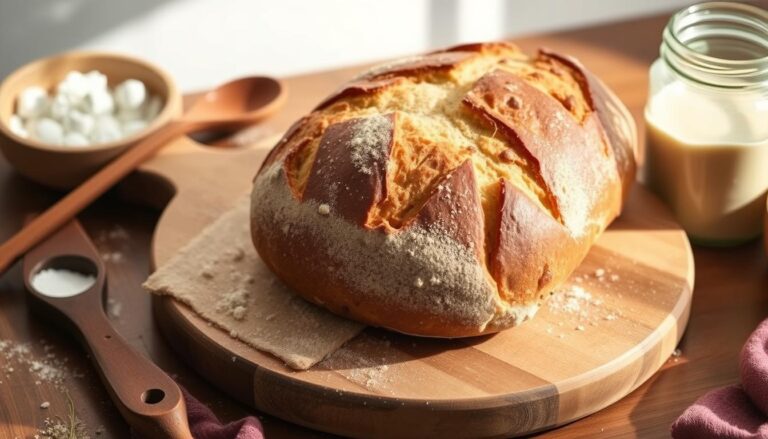Why make overnight sourdough cinnamon rolls?
The moment you pull that pan of golden, swirled perfection from the oven, your kitchen fills with an aroma that instantly transports you back to childhood mornings. That first bite—warm, gooey, and perfectly balanced between tangy and sweet—is pure magic that no store-bought version can match.
I still remember my grandmother rising before dawn to prepare her special breakfast treats. Now, with this overnight method, you can enjoy that same homemade goodness without the early wake-up call. Simply prepare the dough the evening before, then wake to nearly-ready morning delights that need only a brief rise and bake.
These sourdough cinnamon rolls offer something truly special. The natural fermentation process creates layers of flavor that commercial versions simply can’t replicate. Each bite delivers that perfect balance of tender dough, warming spice, and creamy frosting.
What began as a time-saving technique in my kitchen has evolved into our most requested family tradition. Holiday mornings, special celebrations, or just because it’s Sunday—these heavenly spirals have become the centerpiece of our most treasured gatherings.
Table of Contents
The Magic of Sourdough in Cinnamon Rolls
When sourdough meets cinnamon rolls, a beautiful alchemy occurs that transforms both texture and flavor. Unlike their commercially-yeasted counterparts, sourdough cinnamon rolls offer a depth of character that elevates them from a simple sweet treat to a sophisticated culinary experience. The natural fermentation process creates changes on both molecular and sensory levels, resulting in rolls that aren’t just delicious but also potentially more nutritious.
The Unique Tangy Flavor Profile
The hallmark of anysourdough cinnamon rolls recipeis its distinctive flavor complexity. The natural fermentation process creates subtle acidic notes that perfectly balance the sweetness of sugar and spice. This gentle tanginess cuts through the richness, preventing the rolls from becoming cloyingly sweet.
What makes these rolls special is how the flavor evolves with each bite. The initial sweetness gives way to buttery richness, followed by that characteristic sourdough tang that lingers pleasantly on your palate. This complexity means you can actually use less sugar in your recipe while achieving greater flavor satisfaction.
Because of this natural tanginess, many bakers find that traditional cream cheese frosting isn’t necessary. A simple vanilla buttercream often provides the perfect complement, allowing the nuanced flavors of the fermented dough to shine through.
Improved Texture and Digestibility
Beyond flavor, sourdough fermentation dramatically transforms the texture of your cinnamon rolls. The long, slow fermentation process breaks down gluten proteins in ways that commercial yeast simply cannot match, resulting in a uniquely tender crumb structure.
When you pull apart a properly madesourdough cinnamon roll, you’ll notice how it shreds into beautiful, feathery layers. This isn’t just visually appealing—it creates an incredibly satisfying mouthfeel that melts away with each bite.
The digestibility benefits are equally impressive. The natural enzymes in sourdough starter pre-digest much of the flour, breaking down phytic acid and complex carbohydrates. This means your body often processes sourdough baked goods more efficiently than their conventional counterparts.
| Aspect | Regular Cinnamon Rolls | Sourdough Cinnamon Rolls |
|---|---|---|
| Flavor Profile | One-dimensional sweetness | Complex sweet-tangy balance |
| Texture | Soft but uniform | Tender with feathery layers |
| Digestibility | Standard gluten structure | Partially broken-down proteins |
| Shelf Life | 1-2 days before staling | 3-4 days of freshness |
Traditional vs. Sourdough Cinnamon Rolls
Comparing traditional and sourdough cinnamon rolls highlights why many bakers are making the switch to naturally leavened morning treats. While both varieties offer that irresistible spiral of cinnamon-sugar goodness, the differences in preparation method create distinct experiences that appeal to different palates and priorities. Understanding these differences can help you appreciate what makes sourdough cinnamon rolls special and worth the extra time investment.
Flavor Comparison
Traditional cinnamon rolls typically deliver a straightforward sweetness that, while delicious, can be one-dimensional. The commercial yeast works quickly but doesn’t contribute much to the flavor profile.
In contrast, sourdough cinnamon rolls offer a complex taste experience. The fermentation process develops layers of flavor that balance the sweetness with subtle tangy notes. This creates a sophisticated depth that makes each bite more interesting and less cloying.
The natural fermentation also enhances the cinnamon and butter flavors, allowing them to shine through rather than being overwhelmed by sugar. Many describe this as a more “grown-up” version of the childhood favorite, where you can taste every component distinctly.
Texture Differences
The texture contrast between these two varieties is immediately noticeable. Traditional rolls often have a uniform, sometimes dense crumb structure that can become dry more quickly.
Sourdough fermentation creates a distinctly different texture with a tender, light interior. The extended fermentation affects gluten development in remarkable ways, resulting in rolls that pull apart in satisfying, feathery layers.
The exterior develops a slightly more substantial crust while maintaining an incredibly soft center. This textural contrast makes sourdough cinnamon rolls particularly enjoyable, especially when paired with a tangy cream cheese frosting that complements the buttery layers.
Health Considerations
While cinnamon rolls are undeniably treats rather than health foods, the sourdough version offers some nutritional advantages. The fermentation process breaks down phytic acid, which naturally occurs in grains and can inhibit mineral absorption.
This pre-digestion of the flour through fermentation makes minerals more bioavailable and can make the rolls easier to digest for many people. Some studies suggest sourdough fermentation may also reduce the glycemic impact compared to quickly-risen counterparts.
Additionally, the beneficial bacteria created during fermentation contribute to gut health. For those with mild gluten sensitivities (not celiac disease), the extended fermentation can sometimes make sourdough cinnamon rolls more tolerable than traditional versions.
| Feature | Traditional Cinnamon Rolls | Sourdough Cinnamon Rolls |
|---|---|---|
| Leavening Agent | Commercial yeast | Natural sourdough starter |
| Flavor Profile | One-dimensional sweetness | Complex, tangy-sweet balance |
| Texture | Uniform, sometimes dense | Feathery, layered with better chew |
| Preparation Time | 2-3 hours | 8-12 hours (mostly inactive) |
| Digestibility | Standard | Improved through fermentation |
Benefits of the Overnight Method
When you prepare sourdough cinnamon rolls using the overnight method, you tap into a range of benefits that extend far beyond simple convenience. This approach transforms your baking experience by leveraging time as an ingredient itself. The slow, cold fermentation process works silently while you sleep, creating magic in your dough that simply can’t be rushed.
Enhanced Flavor Development
The extended fermentation period of overnight sourdough cinnamon rolls creates a depth of flavor that’s impossible to achieve with quick-rise methods. During those 8-12 hours of rest, complex chemical reactions occur as enzymes break down starches into simpler sugars.
This slow transformation results in a more nuanced flavor profile with subtle tangy notes that perfectly complement the sweet cinnamon filling. The cold temperature of your refrigerator slows down yeast activity while allowing beneficial bacteria to work their magic, creating that distinctive sourdough character.
Many bakers notice that the overnight method also enhances how the dough interacts with the filling, allowing the cinnamon and sugar to partially dissolve and penetrate deeper into the rolls. This creates a more harmonious blend of flavors in every bite.
Time Management Advantages
Perhaps the most practical benefit of making overnight sourdough cinnamon rolls is how efficiently it fits into your busy schedule. Instead of dedicating an entire morning to the process, you split the work between two shorter sessions.
The evening preparation involves mixing your dough, initial fermentation, and shaping your rolls. This typically takes about 30-45 minutes of active time. The bulk of the fermentation happens while you sleep, requiring zero attention from you.
This approach eliminates the frustration of watching dough that seems to rise too slowly. Enriched doughs containing butter, eggs, and sugar naturally take longer to rise than basic bread doughs. The overnight method turns this characteristic from a potential frustration into a convenient feature.
Stress-Free Morning Baking
Imagine waking up to nearly-finished overnight sourdough cinnamon rolls that just need to come to room temperature before baking. This scenario creates a remarkably different morning experience compared to starting from scratch.
With most of the work already done, your morning routine becomes calm and enjoyable rather than rushed and flour-covered. This makes these special treats practical even for busy weekday mornings or holiday celebrations when kitchen stress is the last thing you need.
The psychological benefit of knowing your breakfast is practically ready cannot be overstated. You can focus on brewing coffee and setting the table while your kitchen fills with the irresistible aroma of freshly baking cinnamon rolls—all without the early wake-up call that would otherwise be necessary.
Understanding Sourdough Starter Basics
The journey to exceptional sourdough cinnamon rolls begins with understanding the living culture at the heart of your dough. Your sourdough starter isn’t just an ingredient—it’s a complex ecosystem of wild yeasts and beneficial bacteria that will determine the flavor, texture, and rise of your cinnamon rolls. Whether you’re a sourdough novice or experienced baker, mastering your starter is the crucial first step to breakfast perfection.
A healthy sourdough starter is active, bubbly, and has a pleasant tangy aroma. This living culture requires regular attention and care, much like a pet. The microorganisms in your starter are responsible for both leavening your dough and developing those complex flavors that make sourdough cinnamon rolls so special.
The maturity of your starter also impacts your final product. A young starter (less than a month old) typically produces milder flavors, while a well-established starter (several months or older) contributes more complex, nuanced notes to your cinnamon rolls.
Active vs. Discard Starter for Cinnamon Rolls
When making sourdough cinnamon rolls, the state of your starter matters tremendously. Active starter is one that has been recently fed and is at its peak activity—usually 4-6 hours after feeding when it’s doubled in size and full of bubbles. This is the ideal state for making cinnamon rolls because it provides maximum leavening power.
Using active starter ensures your dough rises properly, creating that light, airy texture we all crave in cinnamon rolls. For best results, feed your starter by combining equal parts flour and water with a portion of your existing starter, then wait until it reaches its peak before mixing your dough.
In contrast, discard starter is unfed and less active. While many recipes call specifically for discard sourdough in cinnamon rolls to reduce waste, these typically require additional leavening agents like baking powder or commercial yeast. The discard contributes flavor but lacks the rising power needed for enriched doughs.
If you do use discard, you’ll need to adjust your recipe accordingly. Many bakers successfully create discard sourdough cinnamon rolls by adding 1-2 teaspoons of baking powder or instant yeast to compensate for the reduced leavening activity.
Maintaining Your Starter for Best Results
Consistent maintenance is key to a happy, productive sourdough starter. For regular bakers, keeping your starter at room temperature and feeding it once or twice daily provides optimal activity. Mix 1/3 cup flour with enough water to create a thick batter-like consistency, similar to muffin batter.
If you bake less frequently, refrigerate your starter to slow fermentation. A weekly feeding is sufficient for refrigerated starters, but remember to revive it with 2-3 feedings at room temperature before making cinnamon rolls.
Look for these visual cues to know your starter is ready for baking:
- Doubled or tripled in volume
- Dome-shaped surface with many bubbles
- Passes the “float test” (a small portion floats in water)
- Pleasant, yeasty aroma without excessive sourness
The consistency of your starter also matters. For cinnamon rolls, a starter with 100% hydration (equal parts flour and water by weight) works best. This balanced hydration level provides reliable fermentation and makes measuring for recipes straightforward.
Planning ahead is crucial when preparing overnight sourdough cinnamon rolls. Begin feeding your starter more regularly 2-3 days before baking day. This “wakes up” the yeast and bacteria, ensuring they’re at peak performance when you need them most.
Essential Ingredients for Overnight Sourdough Cinnamon Rolls
Creating truly memorable overnight sourdough cinnamon rolls begins with understanding the essential ingredients that make them special. While the process matters, the quality and types of ingredients you select will significantly impact your final results. The beauty of a sourdough cinnamon rolls recipe lies in its simplicity—transforming basic pantry staples into something extraordinary through fermentation and technique.
Let’s explore the key components that will elevate your overnight sourdough cinnamon rolls from good to exceptional, focusing on how each ingredient contributes to flavor, texture, and overall quality.
Flour Options and Their Effects
The foundation of any sourdough cinnamon rolls recipe starts with flour selection. Different flours create distinctly different results in your finished rolls.Bread flour, with its higher protein content (typically 12-14%), develops stronger gluten networks that give your rolls structure and that coveted chewy texture. This is particularly helpful when working with sourdough, as the longer fermentation benefits from stronger gluten development.
All-purpose flour produces a more tender crumb and works well when combined with bread flour. For a softer, more delicate roll, you might use a ratio of 75% all-purpose to 25% bread flour.
Adding whole wheat flour introduces nutty flavors that complement the tanginess of sourdough. However, limit whole wheat to about 20-30% of your total flour to maintain proper rise and texture. Specialty flours like spelt or einkorn can add interesting flavor dimensions but may require adjustments to hydration levels.
| Flour Type | Protein Content | Effect on Texture | Flavor Profile |
|---|---|---|---|
| Bread Flour | 12-14% | Chewy, structured | Neutral, slight maltiness |
| All-Purpose | 10-12% | Tender, soft | Neutral |
| Whole Wheat | 13-14% | Denser, heartier | Nutty, earthy |
| Spelt | 11-13% | Delicate, extensible | Sweet, nutty |
Sweeteners and Spices
The sweetener you choose significantly impacts both flavor and texture in your sourdough cinnamon rolls. Traditional white sugar creates a clean sweetness, while brown sugar adds caramel notes that beautifully complement the tanginess of sourdough.
The magic of sourdough cinnamon rolls lies in the balance between tang and sweetness. I find that using brown sugar in the filling creates a perfect harmony with the natural acidity of the sourdough.
For more complex flavors, consider these alternatives:
–Honeyadds floral notes and helps retain moisture
–Maple syrupcontributes rich, woodsy undertones
–Coconut sugarprovides caramel-like flavor with lower glycemic impact
When it comes to spices, cinnamon is obviously essential, but the type matters. Ceylon cinnamon offers delicate, floral notes, while Cassia cinnamon (the most common variety) provides that bold, spicy flavor most associate with cinnamon rolls.
Enhance your spice blend with complementary additions like cardamom (bright, citrusy), nutmeg (warm, nutty), or a pinch of cloves (intense, aromatic). For an unexpected twist, try adding orange zest or vanilla bean to your filling mixture.
Filling and Frosting Ingredients
The filling is where your sourdough cinnamon rolls truly shine. Start withhigh-quality butter—cultured butter adds another dimension of tanginess that works wonderfully with sourdough. Ensure it’s properly softened for easy spreading without tearing your dough.
For the classic filling, combine your chosen sweetener with cinnamon at a ratio of about 4:1. Adding a pinch of salt enhances all flavors and balances sweetness. Some bakers incorporate finely chopped nuts or dried fruits for texture and flavor variation.
When it comes to frosting, cream cheese frosting remains the gold standard for sourdough cinnamon rolls. The slight tanginess perfectly complements the sourdough flavor profile. For a less tangy option, consider a simple vanilla glaze made with powdered sugar, milk, and vanilla extract.
For special occasions, try a brown butter frosting or maple cream cheese variation. Remember that sourdough cinnamon rolls tend to have more complex flavors than traditional versions, so your frosting can be slightly less sweet to allow those nuances to shine through.
Step-by-Step Process for Preparing Overnight Sourdough Cinnamon Rolls
Mastering the step-by-step process for overnight sourdough cinnamon rolls will transform your baking routine and delight your taste buds. This method allows you to do most of the work in the evening, giving the dough time to develop complex flavors overnight while you sleep. By morning, you’ll be ready to bake with minimal effort and maximum results. Let’s break down this process into manageable steps that ensure success every time.
Evening Preparation
The evening preparation phase is crucial for setting up your sourdough cinnamon rolls for success. Ideally, you’ll want to start around 9 PM to give your dough adequate time to develop overnight. This timing creates the perfect schedule for fresh-baked rolls the following morning.
Making the Dough
Begin by combining your active sourdough starter with the wet ingredients in a large mixing bowl. The starter should be at its peak activity—bubbly and doubled in size—for optimal fermentation. In a separate bowl, whisk together the dry ingredients to ensure even distribution.Gradually incorporate the dry ingredientsinto the wet mixture, stirring until a shaggy dough forms. Turn the dough onto a lightly floured surface and knead for 8-10 minutes until smooth and elastic. The proper dough consistency should be slightly tacky but not sticky—it should clear the sides of the bowl but still adhere slightly to the bottom.
If your dough feels too wet, add flour one tablespoon at a time. If it’s too dry, incorporate small amounts of water until you achieve the right texture. Remember that sourdough is more forgiving than you might think!
First Rise Considerations
Place your kneaded dough in a lightly oiled bowl and cover with plastic wrap or a damp kitchen towel. The first rise at room temperature allows the sourdough to begin its fermentation process. You’ll want to let the dough rise for about 2-3 hours at room temperature (around 70-75°F).
During this initial rise, the dough should increase in volume by about 50%. Don’t worry if it doesn’t double in size—the overnight refrigeration will continue the fermentation process. The visual cues to look for include a puffy appearance and a slight dome shape at the top of the dough.
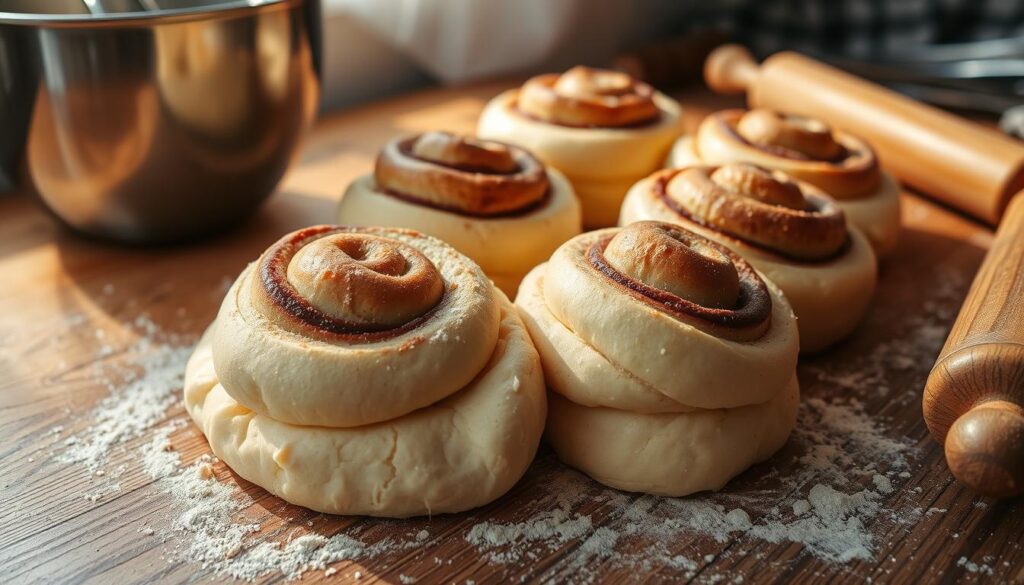
Rolling, Filling, and Shaping
After the initial rise, it’s time to transform your dough into those signature spiral rolls. Turn the dough onto a lightly floured surface and let it rest for 10 minutes. This brief rest relaxes the gluten, making the dough easier to roll out.
Roll the dough into a large rectangle, approximately 17 inches by 12 inches. Aim for an even thickness of about ¼ inch throughout. The rectangle shape is crucial for creating uniform rolls with consistent layers.
For the filling, mix your cinnamon, sugar, and softened butter in a bowl until well combined. Spread this mixture evenly over the dough, leaving about a half-inch border around all edges. This border prevents the filling from oozing out during rolling and baking.
Using a bench scraper (a true game-changer for this recipe), carefully roll the dough into a tight log starting from the long edge. The tighter your roll, the more defined your cinnamon swirls will be. Once rolled, use the bench scraper to cut the log into individual rolls, aiming for 12 equal pieces.
Proper Overnight Storage
The overnight refrigeration is where the magic happens in your sourdough cinnamon rolls recipe. Place your cut rolls in a greased baking dish, spacing them about 1 inch apart to allow room for expansion. Cover the dish tightly with plastic wrap to prevent the dough from drying out.
Cold fermentation in the refrigerator accomplishes several important things. First, it slows down yeast activity while allowing beneficial bacteria to continue developing flavor. Second, it strengthens the gluten structure, resulting in better texture. Finally, it makes the dough easier to handle the next morning.
The ideal refrigerator temperature for overnight storage is between 34-38°F. By morning, you should notice that your rolls have puffed up slightly but not dramatically. This slow, controlled rise is exactly what you want.
| Storage Container | Covering Method | Temperature | Expected Results |
|---|---|---|---|
| Glass baking dish | Plastic wrap | 34-38°F | Slight rise, developed flavor |
| Metal baking pan | Aluminum foil | 34-38°F | Similar rise, potential for drier edges |
| Ceramic dish | Damp kitchen towel + plastic | 34-38°F | Consistent moisture, even rise |
By following these evening preparation steps carefully, you’ll wake up to perfectly proofed sourdough cinnamon rolls ready for their final rise and baking. The overnight method not only develops exceptional flavor but also makes the morning baking process streamlined and stress-free. Your patience will be rewarded with rolls that have that distinctive sourdough tang complementing the sweet cinnamon filling.
Morning Baking Process
The magic happens in the morning when your patiently fermented overnight sourdough cinnamon rolls finally meet the heat of your oven. After hours of slow development in the refrigerator, these rolls are ready for their grand finale. The morning process requires a few key steps to ensure your sourdough rolls achieve that perfect balance of pillowy interior and golden exterior that makes them irresistible.
Bringing Rolls to Room Temperature
Remove your rolls from the refrigerator first thing in the morning. They’ll need approximately 3 hours in a warm spot on your countertop to properly rise before baking. This final rise is crucial for achieving the perfect texture in your overnight sourdough cinnamon rolls.
Look for visual cues that indicate readiness—the rolls should appear puffy and expanded, nearly doubling in size from their refrigerated state. The dough should spring back slowly when gently pressed with a finger.
If your kitchen is particularly cold, create a warmer environment by placing the rolls near (not on) a preheating oven or in an oven with just the light turned on. Avoid rushing this process, as proper rising ensures the characteristic airy texture that makes sourdough rolls special.
Baking Tips for Perfect Texture
Preheat your oven to 350°F while the rolls complete their final rise. Position your baking pan on the middle rack to prevent burning on either the top or bottom of your rolls. This central position allows heat to circulate evenly around the pan.
Bake your overnight sourdough cinnamon rolls for 45-50 minutes, or until they achieve a beautiful golden-brown color. If you’re baking multiple pans, rotate their positions every 20 minutes to ensure even cooking throughout.
“The secret to perfectly baked sourdough cinnamon rolls is patience—they need longer in the oven than conventional rolls to fully develop their complex flavors and ensure the centers are completely baked.”
Test for doneness by inserting a thermometer into the center of a roll—it should read 190°F when fully baked. Immediately after removing from the oven, drizzle any extra cinnamon sugar filling from the pan over the hot rolls for an extra flavor boost.
Frosting Application Techniques
Allow your freshly baked rolls to cool in the pan for about 10 minutes before applying frosting. This brief cooling period strikes the perfect balance—the rolls are still warm enough to slightly melt the frosting but not so hot that it completely liquefies.
For a classic presentation, spread cream cheese or buttercream frosting generously across the entire surface of the rolls while they’re still warm. The heat will help the frosting seep slightly into the crevices, creating pockets of sweet creaminess throughout each roll.
Alternatively, for a more distinct frosting layer, wait until the rolls have cooled completely before applying. This technique creates a more defined visual contrast between the golden roll and white frosting. For special occasions, try piping the frosting in decorative patterns or drizzling it artistically across the top of your overnight sourdough cinnamon rolls for an impressive presentation.
Troubleshooting Common Issues with Overnight Sourdough Cinnamon Rolls
When your overnight sourdough cinnamon rolls don’t turn out as expected, having a troubleshooting guide can help you identify and fix the problem. Even experienced bakers occasionally face challenges with this recipe. The good news is that most issues have simple solutions, and even imperfect rolls can be absolutely delicious.
I’ve always been intimidated by making cinnamon rolls, but the fact of the matter is, perfectly imperfect is just as delicious – and pretty! Don’t fret if you don’t get the tightest roll you want, or yours are a little more rectangular than circular.
Dough Not Rising Properly
A sluggish rise is one of the most common issues with sourdough cinnamon rolls. If your dough seems lifeless, first check your starter’s activity. A healthy starter should double in size within 4-8 hours after feeding.Temperature plays a crucial rolein fermentation. Sourdough thrives in warm environments between 75-85°F (24-29°C). If your kitchen is cold, try these solutions:
- Place the dough in a turned-off oven with just the light on
- Set the bowl near a warm appliance
- Use a heating pad set to low underneath the bowl
If you discover inactive dough in the morning, you can add ¼ teaspoon of instant yeast dissolved in a tablespoon of warm water. Gently work it into the dough and allow an extra hour of rising time before baking.
Addressing Overly Sour Flavor
Sometimes sourdough cinnamon rolls develop an overwhelming tanginess that overpowers the sweet cinnamon flavor. The sourness intensifies with longer fermentation times and warmer temperatures.
To balance an overly sour batch, increase the sweetness in your filling or frosting. Add an extra tablespoon or two of sugar to your filling mixture or incorporate honey into your frosting for natural sweetness.
For future batches, you can reduce sourness by:
- Using a younger, recently fed starter (4-6 hours after feeding)
- Shortening the bulk fermentation time
- Refrigerating the dough sooner
Fixing Dry or Dense Rolls
Dry or dense sourdough cinnamon rolls typically result from either too much flour or underbaking. When mixing your dough, remember that sourdough often requires less flour than traditional recipes. The dough should feel tacky but not sticky.
If your rolls have already baked and turned out dense, try these rescue techniques:For dry rolls:Brush the tops with melted butter while still warm. This adds moisture and softens the crust. You can also serve them with extra frosting or a side of warm custard.For dense rolls:Ensure proper proofing before baking. Underproofed rolls won’t achieve that fluffy texture. The dough should increase in size by about 50% and feel puffy when gently pressed.
Remember that sourdough is incredibly forgiving. Even if your rolls aren’t picture-perfect, their rustic appearance adds homemade charm, and the flavor will still be remarkable. Each batch teaches you something new about working with this living ingredient.
Creative Variations of Overnight Sourdough Cinnamon Rolls
Beyond the traditional recipe, overnight sourdough cinnamon rolls offer endless possibilities for customization and creative expression. Once you’ve mastered the basic technique, you can transform your discard cinnamon rolls into spectacular creations that showcase seasonal ingredients or accommodate dietary restrictions. The beauty of sourdough’s tangy profile is how wonderfully it pairs with both sweet and savory flavor additions.
Seasonal Flavor Adaptations
Each season brings unique ingredients that can elevate your sourdough cinnamon rolls. In fall, incorporate pumpkin puree into your cinnamon sugar filling for a festive twist. Simply mix 1 cup of pumpkin puree with your standard filling for a streusel-like consistency that screams autumn.
Summer calls for fresh fruit variations. Try mixing 1 cup of fresh peaches or blueberries with complementary pie filling, spreading this fruity mixture over your rolled-out dough. After baking, drizzle additional fruit topping for a burst of seasonal flavor. Winter holidays welcome warming spices and cranberry-orange combinations, while spring shines with bright lemon-infused rolls.
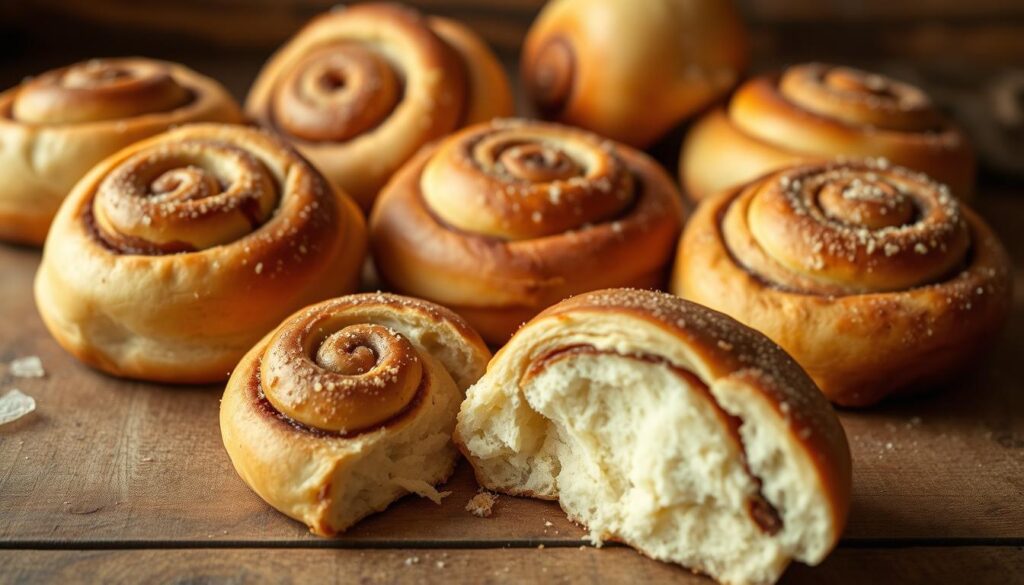
Dietary Modifications
Your favorite discard cinnamon rolls can be adapted for various dietary needs without sacrificing texture or flavor. For vegan versions, replace butter with plant-based alternatives like coconut oil or vegan butter. Substitute dairy milk with almond, oat, or coconut milk, and use flax eggs (1 tablespoon ground flaxseed mixed with 3 tablespoons water) in place of regular eggs.
For gluten-free adaptations, experiment with quality gluten-free flour blends designed for bread baking. Look for options containing xanthan gum to help with structure. Remember that gluten-free sourdough may require longer fermentation times to develop comparable flavor complexity to traditional versions.
Adding Unique Ingredients
Transform ordinary discard cinnamon rolls into extraordinary treats with unexpected additions. Chocolate lovers can incorporate 1 cup of Nutella into the cinnamon sugar filling for a hazelnut-chocolate sensation. The mixture creates a delightful streusel texture that melts during baking.
For a sophisticated twist, try adding chopped pistachios to both the filling and topping. The nuts provide delightful texture contrast against the soft dough. Apple enthusiasts can fold 1 cup of fresh diced apples with apple pie filling into the cinnamon mixture, creating pockets of fruity goodness throughout each roll.
“The best thing about sourdough cinnamon rolls is their adaptability. Your discard starter brings complex flavor that pairs beautifully with everything from chocolate to fruit to nuts.”
Using Discard Starter for Cinnamon Rolls
While active starter is traditional, your sourdough discard can be the secret ingredient to uniquely tangy and waste-free cinnamon rolls. Many home bakers maintain a sourdough starter but struggle to use all the discard produced during regular feedings. Instead of tossing that excess starter, you can transform it into delicious morning treats with a few adjustments.
Adjusting Recipes for Discard
When using discard starter in cinnamon rolls, you’ll need to make several key modifications to ensure success. Since discard lacks the active rising power of fed starter, consider these adjustments:
- Add 1/4 teaspoon of commercial yeast per cup of flour to boost rising power
- Extend the bulk fermentation time by 2-3 hours
- Reduce added liquid by about 1/4 cup to account for the discard’s moisture
- Allow for a longer final proof (up to 10-12 hours overnight)
The acidity level in discard starter affects how your dough handles.You’ll notice the dough may feel slightly stickierthan when using active starter. Combat this by adding flour gradually during kneading until you achieve a smooth, elastic consistency.
Benefits of Using Discard in Cinnamon Rolls
Incorporating discard starter into your cinnamon rolls offers several advantages beyond simply reducing waste. The higher acidity in discard creates a more complex flavor profile with pronounced tanginess that beautifully balances the sweet filling.
Discard starter adds a depth of flavor that’s impossible to achieve with commercial yeast alone. It’s the baker’s secret weapon for cinnamon rolls with character.
The practical benefits are equally compelling. Using discard means you don’t need to plan a feeding schedule specifically for baking cinnamon rolls. This spontaneity makes it easier to bake when inspiration strikes rather than when your starter schedule dictates.
Additionally, the acidity in discard helps break down the flour proteins, resulting in a more tender crumb structure in your finished rolls. This creates a melt-in-your-mouth texture that many bakers find superior to traditional versions.
Storing and Reheating Your Overnight Sourdough Cinnamon Rolls
Mastering the art of storing and reheating your overnight sourdough cinnamon rolls ensures you can savor their exceptional quality well beyond baking day. With the right techniques, you can preserve both the tender texture and complex flavors that make these treats so special. Let’s explore the best methods to extend the life of your homemade rolls.
Short-term Storage Methods
For the first 24 hours after baking, your overnight sourdough cinnamon rolls will stay perfectly fresh at room temperature. Store them in a covered container—glass, metal, or ceramic work best—to prevent them from drying out.
Contrary to popular belief, refrigeration isn’t always ideal for freshly baked goods. The cold air can actually accelerate staling and dry out your rolls. If you must refrigerate them to extend shelf life beyond 2-3 days, use an airtight container and follow this tip:
- Sprinkle a few drops of water on each roll before reheating to restore moisture
- Separate layers with parchment paper to prevent sticking
- Keep frosted rolls slightly separated to maintain their appearance
Freezing and Reheating Techniques
Freezing is your best option for long-term storage of overnight sourdough cinnamon rolls. You can freeze them either before or after baking.
For unbaked rolls, freeze them after shaping but before the final rise. Place them on a baking sheet until solid, then transfer to a freezer bag. When ready to bake, thaw overnight in the refrigerator, then bring to room temperature for 1-2 hours before baking.
For baked rolls, cool completely before freezing. Wrap individually in plastic wrap, then place in a freezer bag. They’ll maintain quality for up to 3 months. To reheat:
- Microwave method: 30 seconds per roll at 50% power, then 10-second intervals until warm
- Oven method: Wrap in foil and heat at 300°F for 10-15 minutes
Always add fresh frosting after reheating for the most authentic just-baked experience.
Conclusion: Why Overnight Sourdough Cinnamon Rolls Are Worth the Wait
The magic of overnight sourdough cinnamon rolls goes beyond their incredible taste. When I first started selling these treats at local markets, they would sell out within the first hour. Thousands of rolls later, customers kept returning for more—clear proof that these aren’t just ordinary breakfast pastries.
The tangy depth that sourdough brings to classic cinnamon rolls creates a perfect balance with the sweet filling. By letting the dough develop overnight, you’re rewarded with a texture that’s both tender and complex. The process might take longer than store-bought versions, but your patience delivers results that no quick recipe can match.
Many of us have childhood memories of waking up to the smell of cinnamon rolls baking. Creating sourdough cinnamon rolls for your family builds on this tradition while adding your personal touch. The aroma filling your home on weekend mornings becomes the backdrop for precious family moments.
Your sourdough journey might include some trial and error, but even imperfect rolls will taste delicious. The skills you develop—from maintaining your starter to mastering the perfect swirl—become part of your baking legacy. These sourdough cinnamon rolls aren’t just a recipe; they’re an experience worth sharing and a tradition worth keeping.

